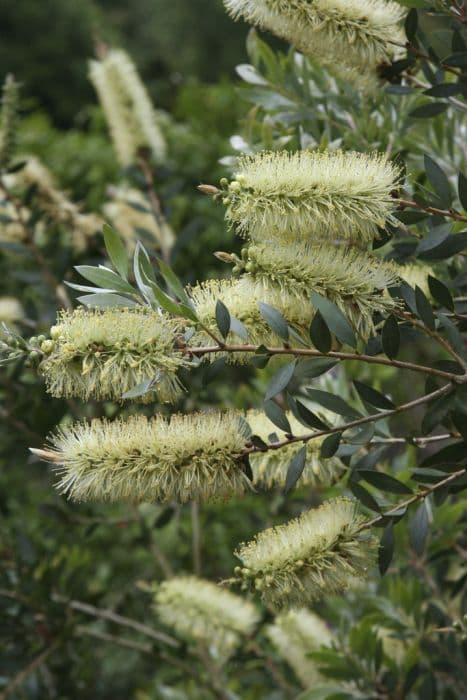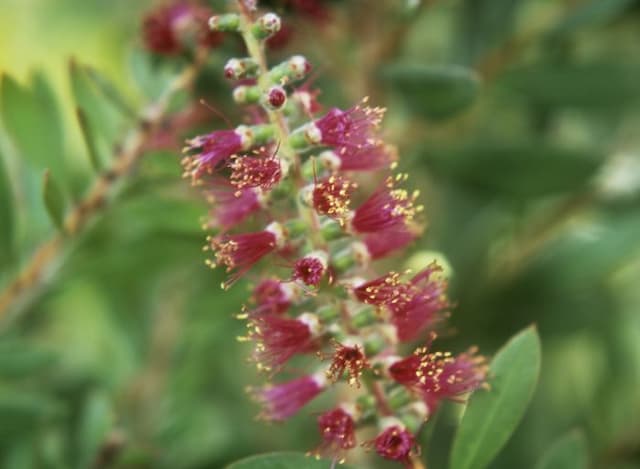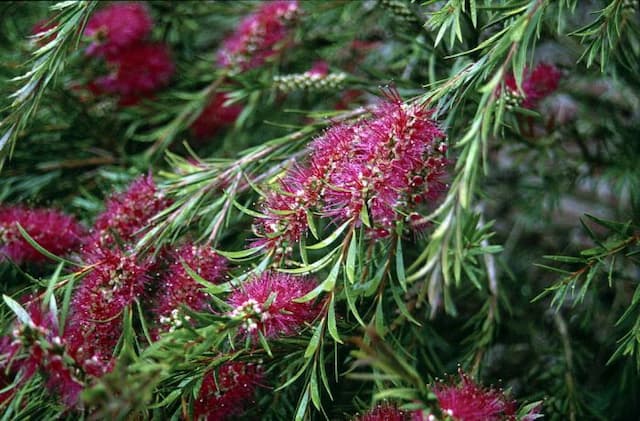Varnished Gum Eucalyptus vernicosa

ABOUT
Eucalyptus vernicosa, commonly known as Varnished Gum, is a visually distinct plant due to its glossy, varnished appearance. It typically boasts a dense, multi-branched structure. Its leaves present a striking blue-green hue and are usually oval-shaped with a tendency to be narrow at both ends, resembling a small sickle. These leaves are often covered in a shiny resin, contributing to the plant's distinctive gleam as though varnished. The smooth bark of Varnished Gum can vary in color from white to greyish hues, often peeling in thin flakes or strips to reveal a layer underneath that might be of a different shade. During its blooming period, it is adorned with clusters of flowers. These flowers are typically white or creamy in color, small, and tightly packed into clustered groupings, which emerge at the ends of the branches. After the flowering phase, the tree produces woody, cone-shaped fruit capsules that house the seeds. These capsules have a distinctively hardened appearance and can remain on the tree for extended periods before releasing seeds. Overall, Varnished Gum is noted for its tough, high-shine leaves and distinctive peeling bark, adding to its unique, attractive appearance. Its leaves, bark, and fruits are all defining characteristics that set it apart from other plants and contribute to its ornamental appeal.
About this plant
 Names
NamesFamily
Myrtaceae.
Synonyms
Varnished Gum, Shiny Gum, Varnish Mallee.
Common names
Eucalyptus vernicosa
 Toxicity
ToxicityTo humans
The plant in question, commonly known as Varnished Gum, contains compounds that can be toxic to humans if ingested. The essential oils, particularly eucalyptol, can be harmful. If someone were to ingest a significant amount of Varnished Gum, they could experience symptoms such as abdominal pain, nausea, vomiting, and diarrhea. In severe cases, poisoning could lead to central nervous system depression and potentially respiratory issues. It is important to avoid consuming any parts of this plant.
To pets
Varnished Gum has the potential to be toxic to pets if they consume parts of the plant. The essential oils and other components can lead to symptoms such as salivation, vomiting, diarrhea, depression, and weakness in animals. In severe cases, ingestion can result in more serious health issues, including central nervous system depression and hepatic failure. It is advised to keep pets away from this plant to prevent any accidental ingestion and ensure their safety.
 Characteristics
CharacteristicsLife cycle
Perennials
Foliage type
Evergreen
Color of leaves
Green
Flower color
Cream
Height
10 feet (3 meters)
Spread
10 feet (3 meters)
Plant type
Shrub
Hardiness zones
7
Native area
Tasmania
Benefits
 General Benefits
General Benefits- Decorative plant – Eucalyptus vernicosa is often prized for its attractive, peeling bark and glossy green leaves, making it an appealing choice for ornamental use in gardens and landscaping.
- Habitat for wildlife – The plant provides habitat and food for various species of birds, insects, and mammals, contributing to biodiversity.
- Shade provider – It can grow to become a reasonably-sized tree that offers shade in gardens, parks, and public spaces.
- Drought resistance – The species is known for its ability to survive in dry conditions, making it suitable for xeriscaping and water-efficient gardens.
- Windbreak – When planted in rows, Eucalyptus vernicosa can act as a windbreak, protecting crops, soil, and structures from strong winds.
- Reforestation – This species can be used in reforestation efforts, especially in its native habitat, to help prevent erosion and restore native ecosystems.
- Economic value – Eucalyptus vernicosa can be cultivated for its timber and essential oils, though it is not among the primary species used for these purposes.
- Aromatherapy – While excluding medical properties, the refreshing scent of the leaves can be used in aromatherapy for creating a calming environment.
 Medical Properties
Medical Properties- Antimicrobial: Eucalyptus vernicosa contains compounds that may have antimicrobial effects against certain bacteria and fungi.
- Decongestant: The plant's essential oil is often used in vapor rubs and inhalants to help relieve congestion.
- Anti-inflammatory: Some components in Eucalyptus vernicosa, like eucalyptol, may help reduce inflammation.
- Analgesic: It may possess pain-relieving properties when used topically as an essential oil or when its leaves are used in traditional remedies.
- Expectorant: Inhalation of eucalyptus steam from the leaves of Eucalyptus vernicosa might help in loosening phlegm and relieving cough.
 Air-purifying Qualities
Air-purifying QualitiesThis plant is not specifically known for air purifying qualities.
 Other Uses
Other Uses- Eucalyptus vernicosa, also known as Varnished Gum, can be used as a source of nectar for bees when in flower, supporting apiaries and contributing to honey production.
- The wood of Varnished Gum is hard and durable, making it suitable for crafting small wooden items such as utensils, ornaments, and specialty woodturning projects.
- The leaves of the plant can be infused in water to create a natural dye for textiles, imparting a yellow or green hue depending on the mordant used.
- The bark of Varnished Gum, which peels off in strips, can be used in crafts for creating textured surfaces on objects like picture frames or mixed-media art.
- Fiber from the bark can also be utilized in the creation of handmade paper, providing a unique texture and scent.
- As a bonsai species, Eucalyptus vernicosa is valued for its attractive bark and small leaves, making it an unusual choice for enthusiasts.
- The dense foliage offers shelter and nesting sites for small birds, providing ecological benefits beyond human uses.
- Dried leaves and seed pods can be incorporated into potpourri mixtures, providing a camphor-like fragrance for the home.
- Culinary enthusiasts sometimes use the leaves to impart a unique flavor to grilled meats, though this is not a common practice and should be approached with caution due to potential toxicity.
- Artists may use the plant's leaves and flowers for botanical prints, a method of capturing detailed plant images on paper or fabric using natural pigments.
Interesting Facts
 Feng Shui
Feng ShuiThe Eucalyptus is not used in Feng Shui practice.
 Zodiac Sign Compitability
Zodiac Sign CompitabilityThe Eucalyptus is not used in astrology practice.
 Plant Symbolism
Plant Symbolism- Healing: Eucalyptus, including Eucalyptus vernicosa (commonly known as Varnished-leaf Gum), is often associated with healing properties, as eucalyptus oil extracted from the leaves is used in medicinal treatments, such as relieving cold symptoms and aiding respiratory issues.
- Protection: In some cultures, eucalyptus branches are believed to ward off evil spirits and provide protection, largely due to their strong scent that is thought to purify the environment.
- Refreshment: Eucalyptus is symbolic of rejuvenation and fresh energy. Its fresh and clean aroma is often used in spas and baths to invigorate the senses and clear the mind.
- Purification: Eucalyptus is believed to purify an area, as it has antiseptic properties. This is why the plant is frequently used in cleaning products and air fresheners.
 Water
WaterVarnished-leaf eucalyptus needs thorough watering when the top inch of the soil feels dry. It is vital not to overwater, so allowing the soil to dry slightly between waterings is recommended. Generally, watering once a week should be sufficient, but this can vary with environmental factors so adjust as needed. When watering, aim to provide about 1 to 1.5 gallons, ensuring water reaches deep into the root zone. During hot and dry periods, increase the frequency to maybe twice a week, but always check the soil moisture first.
 Light
LightVarnished-leaf eucalyptus thrives in full sunlight but can tolerate partial shade. For best growth, place it in a location where it receives at least six hours of direct sun daily. Avoid locations where buildings, trees, or other structures may cast prolonged shadows throughout the day.
 Temperature
TemperatureVarnished-leaf eucalyptus prefers a cool to moderate temperature range and can tolerate temperatures as low as 20 degrees Fahrenheit. The ideal temperature for this plant is between 60 and 75 degrees Fahrenheit, although it can withstand brief periods of higher temperatures. It is important to protect the plant from extreme cold and avoid exposure to temperatures below 20 degrees Fahrenheit to prevent frost damage.
 Pruning
PruningPruning varnished-leaf eucalyptus is important to maintain its shape and promote healthy growth. Prune in the late winter or early spring, before new growth begins. Remove any dead, damaged, or diseased branches, and thin out any crowded areas to improve air circulation. Pruning can be done annually or biennially, depending on the plant's growth rate and your desired aesthetic.
 Cleaning
CleaningAs needed
 Soil
SoilVarnished Gum prefers well-draining soil with a pH range of 5.5 to 6.5. The best soil mix should contain a combination of loam, sand, and peat to ensure proper drainage while retaining some moisture.
 Repotting
RepottingVarnished Gum should be repotted once every 1 to 2 years, ideally during spring when the plant's growth is active. Younger plants may require more frequent repotting due to quicker growth rates.
 Humidity & Misting
Humidity & MistingVarnished Gum thrives best in moderate to low humidity environments, consistent with its native Australian habitat. Avoid excessively high humidity to prevent fungal issues.
 Suitable locations
Suitable locationsIndoor
Provide bright light, airflow, and low humidity for Varnished Gum.
Outdoor
Plant in full sun, protect from frost, and ensure good drainage for Varnished Gum.
Hardiness zone
7-9 USDA
 Life cycle
Life cycleEucalyptus vernicosa, commonly known as Varnished Gum, begins its life cycle as a seed, which germinates in suitable environmental conditions—often after a fire which stimulates the opening of the fruit capsules and release of seeds. Upon germination, the seedling sprouts and establishes a root system, while the shoot emerges and starts photosynthesis. In its juvenile stage, the plant develops distinctive round, sessile leaves that are opposite, glaucous, and blue-green in color. As the plant matures, it enters the adult stage, where the leaves become more elongate, stalked, and green, characteristics that differ from the juvenile form. Varnished Gum eventually flowers, producing white to cream flowers which are pollinated by birds, insects, or wind, leading to the development of woody fruit capsules containing seeds. The mature tree may also resprout after fires from epicormic buds under the bark, lignotubers at the base of the trunk, or from seeds in the soil, thus continuing its cycle.
 Propogation
PropogationPropogation time
Spring to Summer
Eucalyptus vernicosa, commonly known as Varnished-leaf Gum, is typically propagated through seed germination, as this method is most popular due to its relative simplicity and effectiveness. To propagate by seed, collect the capsules after they have matured on the tree and wait for them to dry to facilitate the release of the seeds. Sow the seeds in a well-draining seed raising mix, and cover them lightly with a fine layer of the mix or sand. Ensure the seeds maintain a moist environment by watering gently or misting, and keep them in a warm spot with indirect sunlight. Germination usually occurs within two to three weeks. To increase the chances of success, the seeds can be treated with smoke or smoked water, which is known to stimulate germination in many Eucalyptus species.









